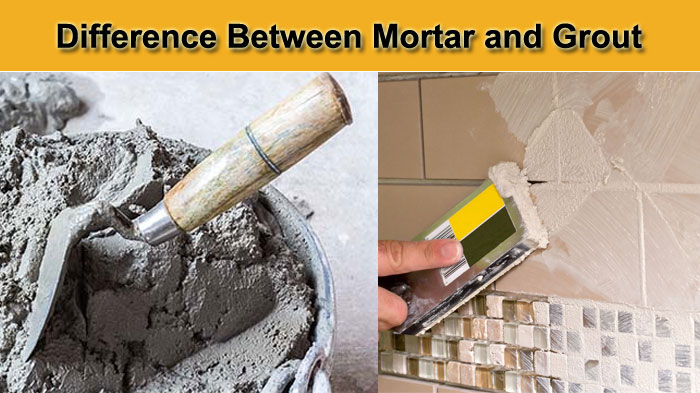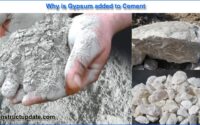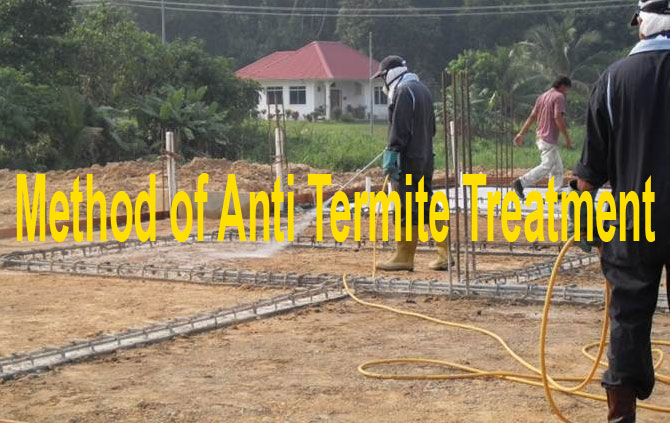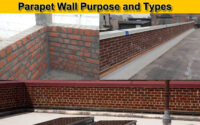Mortar and Grout Types | Difference Between Mortar and Grout
Mortar and Grout are used as binding material in construction. Both are cement based products which differ in serving its purpose, usage and properties. In this article you will learn about Mortar and Grout and their types. We will also show you the difference between Mortar and Grout
What is Mortar?
Mortar is a mixture of cement, sand and water used for binding two surfaces with each other. Used in buildings which serves as binding material between stones, cements, bricks and concrete.
It is a paste prepared by adding an adequate quantity of water into the mixture of binding material such as cement or lime and sand (fine aggregate).
Binding materials such as lime or cement are referred to as ‘matrix’ and fine aggregate as ‘adulterant’. The matrix binds the adulterant particles. The quality and quantity of the matrix are responsible for the durability, quality, and strength of mortar.
The merged effect of both the components of the matrix is responsible for the firm binding of bricks and stones.

Types of Mortar:
Mortars can be classified into the following ways based on the binding agents, possession of binding agents, and aggregate-
- Cement Mortar:
This is the strongest types of mortar that consists of different proportions of sand, water and the binding material i.e. the cement.
Most preferably used as the binding material in the construction for heavy buildings.
- Lime Mortar:
This kind of mortar can be either lime and sand, or lime and surkhi, or lime and cinder also known as black mortar.
Lime used for mortars can be either fat lime (hydrated or quick lime) with high calcium oxide content or hydraulic lime.
Loss of water and absorption of carbon dioxide from the atmosphere and recrystallization in due course is responsible for its hardening.
Hydrated lime is a dry powder obtained by treatment of quick lime with water.
Hydraulic lime has small quantities of alumina and silica or iron oxide, which can be chemically combined with a few contents of calcium oxide, giving a mortar having the property of setting and hardening underwater.
Usage ofSlaked fat lime is for preparing mortar for plastering, whereas usage of hydraulic lime is for preparing mortar for masonry construction.
- Lime-Cement Mortar:
Also known as composite or gauged mortar, cement is added to the lime mortar needed to improve initial setting time and strength with regard to its hydraulic properties.
The quantity of lime mortar with which cement is added should be used within an hour from the time of addition.
- Special Mortar:
There are also special kinds of mortar based on the binding materials and certain characteristics:
- Mud Mortar
- Cement-Clay Mortar
- Light and Heavy Mortar
- Decorative Mortar
- Air entrained Mortar
Test for Mortars:
Several test scan be performed for the quality check of mortars:
- Crushing Strength
- Adhesiveness
- Cohesiveness of Tensile Strength
- Test for Setting
What is Grout?
Grout is a Portland cement-based mixture or a mixture of other compounds to enhance its performance or ease its installation used to filling pints between tiles and is selected with a compatible mortar.
Factors that needs to be considered while selecting grout are:
- Types and size of tile
- Service level
- Climatic Conditions
- Tile Spacing
- Manufacturer’s recommendations
Portland cement-based grout contains a mixture of portland cement and sand for floors or lime for walls. This is used in thickset installations. This kind of grouts includes sand grouts such as portland cement, portland cement, dry set, and latex portland cement.
Other grouts are based on mixtures of compounds that include solid epoxy, silicone, mastic grouts which eliminates the need for mixing on-site.
Types of Grouts:
- Dry-Set Grout:
It is a mixture of sand and portland cement along with additives which improves the retentivity of water.
Features of Dry-Set Grout:
- Suitable for wall grouting
- Eliminates tile soaking
- Latex Grout:
It is a mixture of portland cement and latex additives which increases the stain resistivity also resilience of the joints.
Features of Latex Grout:
- Suitable for ordinary installations.
- Less rigid and less water-permeable which allows movement and great exposure to moisture.
- Suitable for tub and shower areas(washrooms).
- Silicone Rubber Grout:
This is an engineered elastomeric system which includes a single component non slumping silicone rubber, which is stain resistant, moisture free, and prevents cracking and shrinking.
Features of Slicone Rubber Grout:
- Suitable for interior use.
- Prevents Cracking.
- Adheres tenaciously to ceramic tile.
- Cures rapidly, withstanding moisture exposure.
- Epoxy Grout:
It is two or three part mixture (epoxy resin hardener with silica sand filler), highly chemical resistant having great bond strength. These grouts are made for different chemical and solvent resistance.
Epoxy Grout Features:
- Highly stain-resistant and impervious.
- Usage requires special skills which are expensive.
- Might scratch glazed wall tile or mosaic tile as epoxy grouts are formulated without coarse fillers.
- Can be used on floors, walls, and counters that are subjected to food staining.
- Formulated with coarse silica filler for using with quarry tile and pavers.
- Also formulated for industrial and commercial installations where chemical resistance is of paramount importance.
- Has excellent bonding characteristics.
- Furan Resin Grout:
It is a two-part furan mixture (similar to loran mortar) and a hardener which resists high temperatures and solvents.
Furan Resin Grout Features:
- Intended for usage with quarry tile and pavers.
- Used in industrial areas requiring a maximum of chemical resistance.
- Used generally in conjunction with furan mortar.
What are the Differences between Mortar and Grout (Mortar Vs. Grout):
The difference between mortar and grout is mainly the amount of water in the mixture.
Grout must be made with enough water that makes it pourable or pumpable but not with not much water that lets the grout components segregate.
Mortar often is very stiff for flowing around steel into smaller cavities/cores without leaving voids.
| Mortar | Grout |
| More water-cement ratio | Less water-cement ratio. |
| Low Viscosity | HighViscosity |
| Usually takes the cement colour. | Various colour comes according to the requirement. |
| Usually Non-porous. | Quite porous generally. |
| Curing is required for process of hardening. | Extra water is not required for curing. |
| Needs more setting time. | Needs less setting time. |
| Usually used as Binding Material in stone, concrete and brick masonry. | Mainly used as a filler in tiles and cracks. |
| Workability is more, therefore sticks well with a trowel. | Workability is less if compared, as the water content is more, gets difficult handling with tools. |
| Stiffness is more. | Stiffness is less. |
| Materials used for the mixture are cement, sand, lime and water. | Materials used for the mixture arecement, water and sand, epoxy, acrylic and polymer. |





